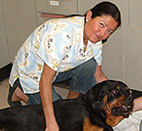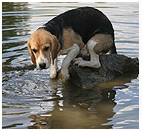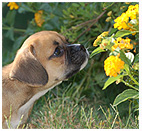Common symptoms in allergic cats:
Cold-like symptoms:
Many pet parents are unaware that their kitty has seasonal allergies because they assume it’s just a cold. However, recurring symptoms shouldn’t be ignored—cats that are allergic to pollen might experience a persistent cough, runny nose and sneezing. Talk to a vet about getting your cat tested for allergies if their symptoms flare up during periods of high pollen in the air.
Skin irritation:
Seasonal allergies usually trigger redness, dryness, itchiness and swelling on the skin. Pet parents may also notice patchy fur and hair loss because their cat is constantly itching the same spots. Serious flare-ups may cause lesions to develop on the skin’s surface that appear crusty or leak discharge.
Secondary infection:
Cats that repeatedly itch the same spot could potentially break open the skin with their claws or teeth. No matter how small, open wounds offer a direct pathway for bacteria to enter the body. As a result, your cat can develop an abscess or bacterial infection. Vets can prescribe antibiotics, but the only way to prevent future infections is to address the cat’s underlying seasonal allergies.
Excessive hairballs:
The occasional hairball is nothing to worry about. Cats ingest small amounts of hair every time they groom themselves. Unfortunately, cats with seasonal allergies will use grooming as a way to itch inflamed, dry skin. Excess hair builds up in the digestive tract and causes your kitty to puke up hairballs a lot more frequently.
Chewing on their paws:
Allergic kitties develop some odd habits, and chewing on the paw pads is one of them. Some pet parents might mistake this behavior as the cat trying to clean out their claws. In reality, seasonal allergies cause the paw pads to become itchy, painful and swollen. Persistent chewing can cause trauma to the paws, and the cat may develop a limp in their walk.
Information provided by: petwellbeing.com
pet tips
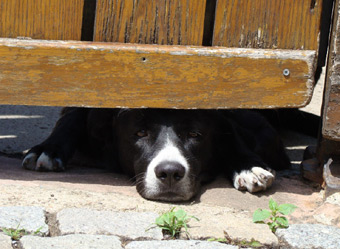
The Doctor Answers Your Questions - April 2023- Cat Allergies
The Doctor Answers Your Questions - March 2023- Pet Poison Prevention
The Doctor Answers Your Questions - January 2023 Pet Teeth Cleaning
Holiday Pet Tips
Fall Pet Tips
Fall Poisons
Flea & Tick Protection
Back to School Separation
Protect Your Pet When Lost
When Giving Pets as Gifts
Separation Anxiety
Your Pet and Extreme Weather or Any Natural Disaster
How to Add Years to Your Pet's Life
Toxic Food and Plants
Spring Pet Tips - Time to Protect Your Pets to Be Outside
Summer Pet Tips
Fall and Winter Pet Tips
Keeping your pet from eating anything you haven’t given them is the first step in protecting your pet. However, we know you can’t watch them all the time, and they might eat something that is not good for them or even will kill them. The following is information to help you determine if your pet has eaten something that is harmful.
Know the signs of poisoning in dogs and cats
While this list is not exhaustive or complete, some common signs of poisoning generally include:
Gastrointestinal Signs
Internal Bleeding
Kidney Failure
Liver Failure
Should you suspect your pet has been poisoned , contact the Pet Poison Help Line by calling 855-764-7661 or go to their website at < agref="https://www.petpoisonhelpline.com/poisons">.
Information provided by; Pet Poison Helpline.
Why do I need to have my pet’s teeth cleaned regularly?
Good dental health is as important for cats and dogs as it is for humans. It is one of the most worthwhile treatments that impacts the general health of your pet. Protect your pet with regular dental exams and care. If your pet has never had its teeth cleaned or not for a couple of years, make an appointment today with the Fulton Animal Hospital to evaluate your pet’s dental health and needs.
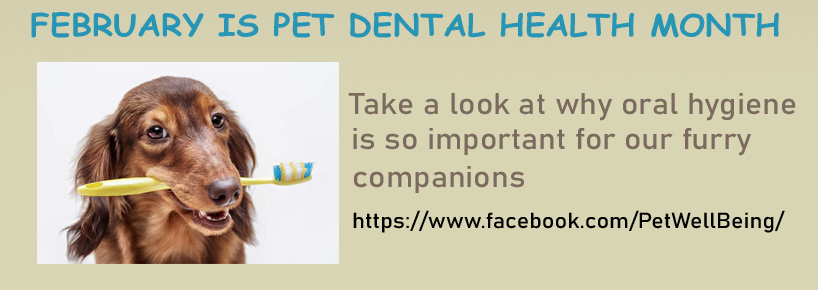
Keeping your pet’s vaccines current is important not only for their general health but because vaccines are developed to last in your pet’s body for a certain amount of time. What happens if the time span between the initial vaccine or booster is longer than the required time set by the medicine’s developer is, the antibodies built up in your pet’s body from previous vaccinations diminish or go away completely. This means, instead of just getting a booster, the next time your pet gets its vaccinations it may need to start from the beginning with their vaccination regime. To avoid this from happening, make sure your pet is vaccinated on the schedule set up by your veterinarian.
If the lapse from annual vaccines has been too long your pet may need a follow up booster after a few weeks. There is an alternative to yearly vaccination, and it involves a blood test to check the amount of immunity in the blood. This is usually much more costly and unless there are health counter indications for your pet to receive a vaccine, such as an adverse reaction, it is very safe. More practical and by far less costly is to give the vaccine regularly.
Train for Guests
With the Holidays on our doorstep, you should get your pet accustomed to having guests over if they aren’t already used to greeting guests whether they are known to them or are strangers. Introducing them to a bunch of new people at once can be very overwhelming and stressful, so you’ll want to slowly ease your pet into meeting new people. Start by having a couple of people over, see how your pet reacts, and keep increasing the count from there. Keep doing this and your pet will be ready to welcome all sorts of guests with open paws when the Holidays or as other activity arrives. Also, remember if they should get outside unattended, micro-chipping will help you to find them, fast! Micro-chipping can be done by the Fulton Animal Hospital.
Food
It’s easy to give in to the begging eyes of your four-legged companion. However, it’s important to know what is and isn’t safe for them to eat.
• Say no to sweets.
We all know dark chocolate is dangerous for dogs and cats, however bread dough and cookie batter are just as dangerous.
• Avoid bones and fatty skin.
Bones can get stuck in your pet’s intestines. Fatty skin is full of fatty juices and butter, which can be difficult for your pet to digest. High-fat foods can also lead to pancreatitis.
• Other foods to avoid.
Walks – Low Light, Mushrooms, Nuts & Flora
When the temperatures get cooler, taking your pet on a walk presents new challenges. With fewer hours of daylight, there’s a good possibility you could be walking in the dark, at least for some of your walks. If possible, walk in well-lit areas, with reflective gear on yourself and your pet. Always keep your pet on a leash. Headlamps are also handy for improving visibility.
Additionally, be watchful for toxic fall flora:
• Acorns - though pets are unlikely to eat enough acorns to cause long-term damage, the ASPCA notes that these seeds contain high concentrations of tannins. When ingested, the tannins can cause gastrointestinal problems like vomiting and diarrhea. In some cases, the FI tract may become obstructed, requiring surgery to remove the obstruction.
• Black Walnuts – can be poisonous and lead to seizures and tremors if eaten by pets. Plus, they often grow mold once they drop, which is another toxic danger.
• Mushrooms – most of the fungus that sprouts in the woods and on lawns are relatively harmless. However, wild mushrooms can be toxic if ingested by pets, causing vomiting and sometimes liver injury, which can be long-term damage, or death. Thus, if fresh fungi is spotted, on your pets walks, give them a wide birth.
• Flowers – not many flowers bloom in cooler weather, but there are a few that need to be watched in respect to your pet. “Autumn Crocus” causes destruction of rapidly dividing cells, which can lead to weakness, vomiting, diarrhea, and less frequently, death. “Lilies” are extremely toxic to cats’ kidneys.
• Trees – dried up leaves should not be sampled by your pet they can lead to gastrointestinal upset. If your pet ingests red berries from a yew or conifer tree, they could have heart arrhythmia or potentially cardiac arrest.
Poisons
• Rodenticide – The drop in temperatures entices little critters, like mice, to seek warm places, like your home. Be careful how you deal with this issue so as to not harm your pet. Rat poison is serious and potentially fatal to your pet. If your pet accidentally eats rat poison, take them to your veterinarian immediately for emergency medical care.
• Antifreeze – When checking the levels of your vehicle’s antifreeze, a small amount can sometimes get onto your driveway or garage floor. Antifreeze is sweet to the taste, which draws your pet to taste it by licking it up. This can cause your pet to have kidney failure and sometimes death. The symptoms of antifreeze ingestion first appear as vomiting and lethargy. This can be followed by neurologic symptoms, including increased drinking, and ultimately, kidney failure.
Prevent & Protect:
Flea and Tick protection is a year-round endeavor. Cooler temperatures doesn’t mean you can cool it on external parasite control. Fleas and Ticks are more active during the winter than most pet owners realize. They remain active as long as temperatures are above freezing and the ground isn’t frozen or covered in snow. Black-legged ticks which can transmit Lyme disease are particularly active in the fall. Ticks can be found in damp area, tall grass, bushes, trees, etc. Keep this in mind when your pet is outside whether on a walk or just outside playing. Take extra care to not go off-trail if you bring your pet with you on a hike and be sure to check them thoroughly for ticks once you finish your hike or walk. Humans need to be as careful about ticks for themselves as they are with their pets and need to take the same precautions.>br>
Fighting Fleas:
For flea control, vets advise using only one type of treatment, topical meds. In general, oral meds aren't advised for pets who have seizures, and cats should never wear collars containing permethrin, which can be toxic to them. When you start treatment depends on when fleas are prevalent in your area. Fleas thrive year-round in some climates and only in warm months in others. With products that prevent fleas, less is more and only use them on an as-needed basis. There are natural products that can be used, but they tend to be less effective.
If you see any fleas on your pet, remove them pronto! Brush out your pet's coat with a flea comb, then give her/him a bath with a pet shampoo. Treat the house. Wash your pet's bedding in hot water and vacuum everywhere. Sprinkle Borax where fleas congregate: baseboards, under furniture, carpets; keep pets out of those rooms for at least 48 hours and vacuum after 12 to 48 hours. If the infestation is bad, you may need to fumigate. Also talk to your vet about treating for tapeworms; pets with fleas are at risk.
Taking on Ticks:
In addition to a regular tick-prevention regimen, stay on top of yard upkeep. To help prevent flea and tick infestation, keep grass short, trim trees and bushes, and rake up piles of leaves. A nontoxic way to kill ticks and fleas in the yard is to sprinkle diatomaceous earth (a powder made from fossilized algae). Check your pet's coat daily. On a dog, ticks are commonly found in ears, ear fold, and corners of eyes; on the neck; between toes and the body and legs. On a cat, prime spots are the face and neck.
The longer the tick stays attached, the higher the risk of transmitting disease. Use tweezers or a tick-removing tool to remove the entire tick without crushing or twisting it; leaving any part of the tick could cause an infection. Call your vet; she may start your pet on an antibiotic to ward off any chance of a tick-borne illness developing, which can take months to show up on tests or cause symptoms. Watch for signs of illness, including lethargy and joint swelling that can lead to limping.
Adapted from material originally posted on BH&G magazine, Karen Asp
Cats and dogs who are used to daily company during school holidays, especially during summer vacation, can experience distress when the children go back to school. The house is suddenly empty and quiet. This is the perfect environment for your pet to get into trouble. Some of the activities your pet may resort to are: house soiling, chewing or scratching inappropriate items and howling or barking.
To help your pet adjust to the new situation, try softening the transition by devoting time to play and bonding with your pet before you leave home and when you return.
If you suspect your pet has Separation Anxiety, seek help from your veterinarian. They will work with you as a team to get you and your pet through this challenging disorder.
Chip and ID:
Get your pet microchipped. Microchipping doubles the chances of your pet being returned to you if it is lost or abducted. Ask your vet about microchipping; if you adopt from a shelter, it often will chip your new pet, often for free. Once the chip is implanted, register your contact info and always update it if you move.
Added Insurance:
Provide your pet with a personalized collar with your phone number or buy a nylon one you can write on (tags can fall off) so you can be contacted directly if your pet is found.
Home Prep (have these items):
Good Photos: Take pictures of your pet from different angles. Focus on any unique markings with one on all fours.
Act Fast
If your pet has gone missing, you plan of action is to:
- Social Media: post your pets photos, identifying info and exact location last seen.
- File Lost Report: file at local shelters and visit them every one or two days. Always ask to see all the pets, including stray pickups.
- Flyers: put up in all areas where your pet could be. Include a photo of your pet standing on all fours, a full description, reward info and your phone number.
Sightings: check all out.
For cats: move their litter box to the porch. Their noses can pick up the scent from up to a mile away. Set out food and water, provide the ability for your cat to get inside (like a garage) if possible.
Per BH&G, Karen Asp
Discuss the Responsibilities
A pet as a gift shouldn't be a surprise. Pets take commitment, so you need to be sure the family is prepared to welcome a new pet into their household. Pets are a great way to teach kids responsibility, but keep in mind the age of the child receiving the pet and what contribution they can make to its care.
Launch Your Search
Start by doing thorough research on pets and their needs in general. Also learn about different breeds and their needs. Once you've narrowed down the kind of pet that might be a fit for the household, turn to shelter and rescues, they can recommend pets based on the traits identified. (Petfinders.com lists dogs and cats available at more than 11,000 shelter and organizations.)
Shelters/Rescue Organizations: Costs for adoption fees from shelters and rescue organizations are generally going to be significantly less than buying from a breeder, and the pet is probably already vaccinated, microchipped and spayed or neutered. Plus, if you have any training or behavior issues after adopting, they can typically provide information and resources you can contact.
Breeders: If you want to go the breeder route, choose a responsible breeder and research any prospects. A home visit is mandatory to see conditions and meet the parents. While there, get references and ask about any requirements, guarantees, and medical records.
Holiday Gift?
Giving a pet as a Holiday gift itself is something to weigh carefully. "It can be overwhelming for pets to go to a new home, more so if there's lots of activity and stimulation." Wrap a card that says you're paying for the adoption fees, then look for the pet together. Add the Basics, consider including essentials in your gift like a leash, collar, food and water owls, and toys to set the new pet parent up for success from the start.
Per BH&G, Karen Asp
Prevent & Protect:
Fighting Fleas:
For flea control, vets advise using only one type of treatment, topical meds. In general, oral meds aren't advised for pets who have seizures, and cats should never wear collars containing permethrin, which can be toxic to them. When you start treatment depends on when fleas are prevalent in your area. Fleas thrive year-round in some climates and only in warm months in others. With products that prevent fleas, less is more and only use them on an as-needed basis. There are natural products that can be used, but they tend to be less effective.
If you see any fleas on your pet, remove them pronto! Brush out your pet's coat with a flea comb, then give her/him a bath with a pet shampoo. Treat the house. Wash your pet's bedding in hot water and vacuum everywhere. Sprinkle Borax where fleas congregate: baseboards, under furniture, carpets; keep pets out of those rooms for at least 48 hours and vacuum after 12 to 48 hours. If the infestation is bad, you may need to fumigate. Also talk to your vet about treating for tapeworms; pets with fleas are at risk.
Taking on Ticks:
In addition to a regular tick-prevention regimen, stay on top of yard upkeep. Ticks prefer damp areas, tall grasses, and shrubs, so keep grass short, trim trees and bushes, and rake up piles of leaves. A nontoxic way to kill ticks and fleas in the yard is to sprinkle diatomaceous earth (a powder made from fossilized algae). Check your pet's coat daily. On a dog, ticks are commonly found in ears, ear fold, and corners of eyes; on the neck; between toes and the body and legs. On a cat, prime spots are the face and neck.
The longer the tick stays attached, the higher the risk of transmitting disease. Use tweezers or a tick-removing tool to remove the entire tick without crushing or twisting it; leaving any part of the tick could cause an infection. Call your vet; she may start your pet on an antibiotic to ward off any chance of a tick-borne illness developing, which can take months to show up on tests or cause symptoms. Watch for signs of illness, including lethargy and joint swelling that can lead to limping.
Adapted from material originally posted on BH&G magazine, Karen Asp
As the kids head back to school, consider that your dog may have to adjust to the changes in the family routine just like everyone else. During the summer, your children and the family dog can develop a strong bond. Now there's suddenly an empty and quiet house. This change in routine can cause your dog to suffer from separation anxiety or depression - to actually miss your kids - and even follow them to school if it gets out of the house.
Note: Some dogs have anxiety at any time when left alone, not just when the kids go back to school.
Signs of Separation Anxiety through destructive behaviors:
- - Chewing furniture
- - Ripping the stuffing out of pillows
- - Shredding paper
- - Obsessive barking/whining for extended periods of time
- - House soiling
**Separation anxiety is a serious condition that can be managed with structure and patience. NEVER punish your dog for exhibiting this behavior, as it will make him more fearful and potentially aggressive.
Managing Anxiety:
- - Start with leaving your dog at home for very short periods of time to get him used to being alone
- - Avoid emotional departures and greetings.
- - Have your belongings prepared so that your departure from home is calm.
- - Consider doggie daycare for prolonged absences.
- - Teach the kids to avoid over stimulating the dog with departures and arrivals.
- - Exercising your dog before leaving the house in the morning is a good idea so he'll be relaxed when you return and be set for when you're away.
- - Leave some sturdy, interactive toys for your dog to help keep him from being bored.
**Be sure to check with your veterinarian to have your dog fully evaluated and correctly diagnosed before trying to manage the symptoms. There may be an underlying medical condition that could be misconstrued as separation anxiety.
Be Prepared
Hurricanes, floods, brushfires, tornadoes or any other natural disaster can be frightening things to be caught in. But with some forethought and preparation, you can make the situation easier and safer for you and your pet.
1. Make a Plan
Decide on a course of action and make sure you can initiate it at a moment's notice. Have supplies set aside in a safe, easily accessible place. It's like having candles or a flashlight under the kitchen sink in case of a black out. You may never need them, but if a blackout happens, there's no need to scramble in the dark, because you know exactly where to go and what to do for light.
2. Be a Stickler
Whatever your decision is, stick to it. Otherwise, you may put your pet in real danger. If you decided to leave town at the first sign of warning, then do so as planned. No dilly-dallying. Changing your mind or changing the plan often leads to unnecessary accidents, as you're no longer prepared.
3. Get Your Kit On
A pet emergency kit isn't that much different to yours. Enough water for three days, non-perishable food (include a can opener if needed), a solid carrier, litter, litter box, puppy pads, plastic bags, medicine and medical records for both you and your pet in waterproof containers, extra leash, and a picture of your pet on you in case the worst happens and you get separated. Tags and/or microchipping your pet will also make it easier to recover, should it get lost.
4. Staying In
If you're staying home to ride out the storm, keep your pet in its carrier or on a leash. You never know when you might be forced to evacuate. And even if that doesn't happen, you don't want to be tracking down a petrified pet during the chaos. Therefore, secure your pet before the storm hits.
5. Going Out
Stay tuned to the news reports. If you're told to evacuate, you must do so at first warning. Moreover, it helps to have everything ready to go. We suggest a backpack that holds all the essentials for you and your pet. And make sure you know ahead of time exactly where all the shelters are and how to get there.
6. Stay Calm
Whether you leave early, choose to stay, or are required to evacuate due to the severity of the storm/disaster or due to house damage, remember to stay calm. Your pet can sense your emotions, so a calming demeanor can lead to a less-panicked pet. Oh, and don't forget to speak to your pet in a calm, soothing voice, too.
Feed A High Quality Diet - Pets fed a high quality diet have a shiny coat, healthy skin, and bright eyes. A good diet can help strengthen your pet's immune system, help maintain intestinal health, help increase mental acuity, help keep joints and muscles healthy, and much more.
Keep Your Pet Lean - Pets that are overweight are at risk for a myriad of health issues. Obesity is the number one nutritional disease seen in pets currently and studies have shown that being overweight or obese can shorten a dog or cat's life span by as much as two years. Being overweight or obese puts your pet at risk for joint disease, heart disease and diabetes, among other things.
Take Your Pet to the Veterinarian Regularly - All pets require regular veterinary care. However, veterinary care goes far beyond routine vaccinations, even though those are important by uncovering health issues of which you are unaware. In many cases, an early diagnosis improves the chances of successful treatment and is also likely to be less costly than waiting until your pet's illness has become advanced and serious before attempting treatment.
Keep Your Pet's Mouth Clean - A common problem among dogs and cats, dental disease and oral health issues can cause your pet pain, making it difficult to eat. If left untreated, oral health issues may lead to heart and kidney disease. In addition to regular dental checkups, the most effective means of caring for your pet's mouth at home is brushing their teeth at home. If your pet isn't a big fan of toothbrushes there are other alternatives, including dental diets, treats, and toys. Ask your veterinarian for recommendations.
Don't Allow Your Pet to Roam Unsupervised - Allowing your dog or cat to roam free may seem like you're doing them a favor. However, pets that roam are susceptible to a number of dangers, including automobile accidents, predation, exposure to contagious diseases, exposure to poisons, and more.
Hazardous Ingredients. In addition to sweets and booze, remember that caffeine, garlic, onion, and tomatoes are not recommended for pet consumption. Sugar alone can cause stomach upset in pets.
Bones. Poultry and fish bones can damage a pet's digestive tract, or they can choke on them.
Turkey Skin As tempting as turkey skin is, it can be extremely hazardous to your pet's life and is difficult for them to digest. Symptoms include vomiting, abdominal pain and lethargy.
Fat. Fatty leftovers can lead to stomach upset, weight gain and even pancreatitis.
Raw Dough. Uncooked bread dough can cause a condition called gastric-dilatation volvulus (GDV), which is a twisted stomach that can unfortunately lead to death.
Nuts. Macadamia nuts and moldy walnuts can be toxic, causing vomiting, loss of muscle control, seizures and other neurological problems. Almonds, fresh walnuts and pistachios are less dangerous, causing an upset stomach or if swallowed whole, obstructing the digestive tract.
It bears Repeating: sugar-free, pinwheel peppermints and other xylitol-containing items are a big no-no! If your pet eats anything containing xylitol, including certain kinds of gum, toothpaste and baked goods, you will need to rush them to the vet immediately. Xylitol poisoning can be fatal.
Nutmeg. In your eggnog, some lattes, cakes, pumpkin pies, and especially gingerbread cookies, nutmeg can be lethal to dogs. If your pup scarfs something down with nutmeg in it, call your vet ASAP.
Cleaning and Home Products. Be sure to keep all cleaners and chemicals out of your pet's way! Almost all cleaning products, even all natural ones, contain chemicals that may be harmful to pets. Also, products such as paints, mineral spirits and solvents can be toxic to your pets. Physical hazards, including nails, staples, insulation, blades and power tools can also be harmful.
Plants
While some holiday plants only end in tummy upset, it's worth it to steer clear of the following:
Holly - These classic holiday beauties can be make for an ugly holiday experience if your dog or cat eats them. The main symptoms include drooling, vomiting, diarrhea, loss of appetite, and decreased activity.
Mistletoe - Severe mistletoe toxicity is uncommon, but if your pet has a big appetite for mistletoe, they could be very uncomfortable. Symptoms include vomiting and diarrhea, difficulty in breathing, slowed heart rate, low blood pressure, and odd behavior.
** A quick and easy pet proof for the holidays can do wonders for your peace of mind (and peace on earth). Make sure the above ingredients, plants, and decorations are out of paw's reach and you'll have a much quieter holiday season.
From HealthyPawsPetInsurance.com All rights reserved
When the weather starts to get warmer and winter is giving way to spring, pet owners need to be sure their outdoor space is pet-friendly before their four-legged friends can run freely outdoors. It's easy to create a pet-scaped yard that is free of chemicals and safe for paws. Pass on Pesticides, use organic lawn care products. No-No on Cocoa mulch. Investigate plants, before planting.
Pet owners need to remember with the warm months approaching it is prime flea season and time to stock up on flea prevention. For cats, topical prevention is best. For dogs, topical and oral are both preferred preventions. Year-round heartworm preventive medication is also important consideration for your dog at this time of year. (See Flea and Tick Control in Pet Tips.)
With the warmer weather means most of our Canine companions will be spending more time outdoors. If you frequent dog parks, go to doggie day care, board or have your pet groomed, it is recommended that your pet be vaccinated every 6 months with the Bordetella vaccine and yearly with the Canine Influenza vaccine. These vaccines are given additionally to the CORE vaccines of Distemper Combination Vaccine and Rabies Vaccine. Along with more trips to the park, warmer weather means longer walks and more chances for your pet to wander off! Make sure your dog or cat has a microchip for identification and wears a tag imprinted with your home address, cell phone and any other relevant contact information. Microchipping your pet can be easily done by the Fulton Animal Hospital.
As days become warmer and sunnier, cats love spending time in the garden. Make sure your garden is safe for your cat and be careful if you need to use any garden pellets, pesticides or other chemicals. Avoid using cocoa shell mulch, it is toxic to pets (it contains the same ingredients as chocolate). Watch out for poisonous plants: common species are lilies, daffodils, and azaleas.
With warm weather play time, be sure your pet does not get overheated and stays hydrated by providing water outside.
** If you suspect your pet may have come in contact with or ingested a potentially poisonous substance, contact the Fulton Animal Hospital (301) 490-7667, your local veterinarian or the ASPCA Animal Poison Control Center immediately at (888) 426-4435.
Do Not Leave an Animal in a Hot Car - Heatstroke Can Kill, and Fast!
On an 85-degree day, for example, even with the windows open, the temperature inside a car can climb to 102 degrees in 10 minutes, and to 120 degrees in 30 minutes. An animal's body temperature of 107-108 degrees for only a very short time can cause suffering and irreparable brain damage ... or death. It is easy for early signs of heatstroke to go unrecognized, and for the pet to be in an emergency situation within mere minutes.
The typical signs of heatstroke are:
- Panting
- High body temperature
- Dehydration
- Red mouth/eye membranes
- Rapid, irregular heart rate
- Diarrhea
- Weakness, looking dazed
- Coma
If a pet begins exhibiting any of these signs, contact a veterinarian immediately.
Also, use caution during warm weather months when leaving animals outside in yards or on porches. Never leave them outside extended periods of time. Ensure appropriate shade and water are always available.
KEEP PETS SAFE WHILE OUTSIDE - Cats should be kept indoors at all times of the year and never allowed to roam loose, unprotected and unsupervised. During the hottest and most humid parts of the day, bring dogs in the house. And remember ... pets can get sunburned too. Speak with your veterinarian about applying sunblock to your pet's sun-sensitive areas, such as nose and ears.
As the weather gets colder, pets should stay inside where it is warm. Under no circumstances should pets be left outdoors, for long periods of time. Dogs should only be taken out for walks and exercise.
If your dog is outdoors much of the day, for any reason, they should be protected by a dry, draft-free shelter with a raised floor and the door covered with burlap or heavy plastic. Pets who spend a lot of time outdoors need more food and water in the winter because keeping warm depletes energy.
No matter what the temperature is, windchill can threaten a pet's life. Exposed shin on noses, ears and paw pads are at risk for frostbite and hypothermia during extreme cold snaps. For this reason, short-haired dogs often feel more comfortable wearing a sweater - even during short walks. Never shave your dog down to the skin in cold months. A longer coat will keep him warm. And when you bathe your pet, make sure he is completely dry before taking it outdoors. Use petroleum jelly or another protectant on paws to keep them from cracking and becoming irritated.
Puppies do not tolerate the cold as well as adult dogs and may be difficult to housebreak during the winter. If you puppy seem sensitive to the weather, you may opt to paper-train it inside. If necessary, take your puppy out to relieve itself very briefly and bring it inside and dry him off thoroughly.
Rock salt and other chemicals used to melt snow and ice can irritate the pads of your pet's feet. Always wipe all paws with a damp towel when your pet comes inside and before they lick them and irritate their mouths.
Antifreeze is a deadly poison, but it has a sweet taste that may attract animals and children. Wipe up any antifreeze spills immediately.
Another product used often during the fall and winter is rodent poison. This can be fatal if ingested. Rodent poison causes severe blooding abnormalities.
During the winter months, outdoor cats will often sleep under the hoods of cars. Before you start your car, bang loudly on the hood to give the cat a chance to escape.
Christmas Holiday.
If you already know the basics of holiday safety for dogs and cars, especially where it relates to food, the following are other considerations about what can be toxic or hazardous of your pet ingests them.
Loose Christmas tree needles - Loose needles pose two big problems: swallowing them can lead to intestinal blockages or puncture wounds. Additionally, they can get stuck in paws and cause minor wounds to full abscesses that will need vet attention.
Chewing on fir branches can also lead to irritation of the mouth, causing excessive drooling and vomiting.
Tinsel is easily swallowed by pets and can easily form severe intestinal blockages. Surgery can be required to remove these obstructions.
Choking on ribbon - Like tinsel, ribbon is a major choking hazard, and if it makes it's way into your dog or kitty's intestines, they may need emergency surgery.
Eating ornaments, especially those made of glass, is hazardous as they can become lodged in your pet's digestive tract. Broken ones can also cause internal bleeding if swallowed, or painful if stepped on.
Popcorn or cranberry garlands are appetizing to pets, which will often do anything for a tasty treat. Plus if the garland is treated with toxic shellacs, your pet could get very sick.
Tree accidents, dogs, and especially cats, will jump on the tree to get at the decorations which can lead to accidents and injury.



